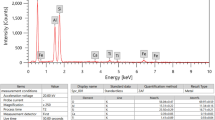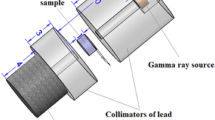Abstract
Radiation attenuation and absorption play a crucial role in various applications, such as nuclear power generation, medical imaging, and space exploration. Clay minerals, with their unique layered structure, offer potential as radiation shielding materials due to their exceptional properties and tunability. The systematic tuning of the tetrahedral-to-octahedral-layers ion content (T:O ratio) in muscovite, a variant of mica, by substitution of Al by Fe and investigation of its impact on radiation shielding is the primary goal of this study. The linear attenuation coefficient (LAC) and mass attenuation coefficient (MAC) were calculated for a range of photon energies for different clay minerals, revealing that the MAC values depend on the incident photon energy, crystalline form and chemical composition. The sequential order for the MAC values at E = 50 keV as follows: (Clay, MAC (cm2.g−1)): (mica, 0.357), (talc, 0.307), (kaolinite, 0.297), (montmorillonite, 0.286). The LAC values also demonstrated variations with the same order in relation to incoming radiation, where mica (with unit-cell volume 943.6 A˚3, crystal density 3.02 g.cm−3, atomic packing fraction 0.226) exhibited the highest values. Also, the results indicate that muscovite exhibits improving shielding properties as the ion content T:O ratio is increased from 20:0 to 20:10, corresponding to an increase in Fe3+ ions at the expense of Al3+ ions in the octahedral voids. Its MAC values at 0.015 MeV were increased from 7.146 to 10.403 cm2.g−1 as the T:O substitution ratio increased from 20:0 to 20:10 in the layered clay. The findings highlight the importance of optimizing the T:O substitution ratio in clay minerals for radiation-shielding applications.
Similar content being viewed by others
Data Availability
No datasets were generated or analysed during the current study.
References
Chilton AB, Shultis JK, Faw R (1984) Principle of Radiation Shielding, 1st edn. Prentic-Halle, Englewood Cliffs
Murray HH (2006) Applied Clay Mineralogy: Occurrences, Processing and Applications of Kaolins, Bentonites, Palygorskitesepiolite, and Common Clays, 1st edn. Elsevier Science, Amsterdam, The Netherlands
Bergaya F, Lagaly G (2013) Handbook of Clay Science, vol 5, 2nd edn, Elsevier Science, Amsterdam, The Netherlands
Wang H, Sun Y, Chu J, Wang X, Zhang M (2020) Crystalline structure variation within phlogopite, muscovite and talc under 0–1000 kGy γ ray irradiation: a clear dependence on intrinsic characteristic. Appl Clay Sci 187:105475. https://doi.org/10.1016/j.clay.2020.105475
Wang H, Sun Y, Chu J, Wang X, Zhang M (2020) Appl Clay Sci 187:105475
Allard T, Calas G (2009) Appl Clay Sci 43:143–149
Allard T, Balan E, Calas G, Fourdrin C, Morichon E, Sorieul S (2012) Nuclear Inst Methods Phy Res B 277:112–120
Huang X, Li J, Xiaoya Su, Fang K, Wang Z, Liu L, Wang H, Yang C, Xiaoguang W (2021) RSC Adv 11:21870
Halliwell E, Couch C, Begum R, Li W, Maqbool M (2021) Colloids Surf A Physicochem Eng Asp 622:126646
Li G, Sui X, Qin X, Ma Y, Wang K, Wang Q (2016) Phys Lett A 380:3500–3504
Chai P, Abramchuk M, Shatruk M (2016) Crystals 6:165
Khattari ZY, Alsaif NAM, Shams MS et al (2023) Silicon 15:4897–4907
Couch C, Halliwell E, Begum R, Ali G, Khan T, Maqbool M (2022) J Appl Cryst 55:615–620
Khattari ZY (2024) Opt Mater 149:115000
Khattari ZY (2024) Silicon 16:1753–1764
Khattari ZY (2024) Radiat Phys Chem 219:111660
Khattari ZY (2024) Opt Mater 150:115197
Al-Omari S, Afaneh F, Alsaif NAM, Al-Ghamdi H, Rammah YS, Khattari ZY (2024) Radiat Phys Chem 217:111527
Shaaban SM, Afaneh F, Elsad RA et al (2024) Silicon 16:407–414
Al-Omari S, Shaaban SM, Rammah YS et al (2023) Silicon 15:7865–7873
Khattari ZY (2024) J Am Cerm Soc 107:3761–3768
Al-Omari S, Afaneh F, Elsad RA, Rammah YS, Khattari ZY (2024) Radiat Phys Chem 215:111377
Khattari ZY (2024). Silicon. https://doi.org/10.1007/s12633-024-02904-1
Khattari ZY (2024). Silicon. https://doi.org/10.1007/s12633-024-02945-6
ANSI/ANS-6.4.3; W2001 (1991) Geometric Progression Gamma-Ray Buildup Factor Coefficients, American Nuclear Society, LaGrange Park, Illinois
Berger MJ, Hubbell JH, Seltzer SM, Chang J, Coursey JS, Sukumar R et al (2010) XCOM: Photon cross section database, version 1.5. http://physics.nist.gov/xcom. Accessed 10 Mar 2024
Şakar E, Özpolat ÖF, Alım B, Sayyed MI, Kurudirek M (2020) Radiat Phys Chem 166:108496
Kittel C (2005) Introduction to Solid State Physics, 8th edn. John Wiley & Sons, Hoboken
Ashcroft NW, Mermin ND (1976) Solid State Physics. Saunders College Publishing, Rochester
Wells AF (1984) Structural Inorganic Chemistry. Clarendon Press, Oxford (ISBN 0-19-855370-6)
Pauling L (1940) The Nature of the Chemical Bond and the Structure of Molecules and Crystals, 2nd edn. Cornell University Press, Ithaca
Fuochi P, Corda U, Lavalle M, Kovacs A, Baranyai M, Mejri A, Farah K (2009) Dosimetric properties of gamma and electron-irradiated commercial window glasses. Nukleonika 54:39–43
Bootjomchai C, Laopaiboon R (2014) Thermoluminescence dosimetric properties and effective atomic numbers of window glass. Nucl Inst Methods Phys Res B 323:42–48
Wei W, Hong Y, Yuan Y, Li Y, Cui K, Zhang T, Jia X, Qin W, Wu X (2023) J Alloys Compd 938:168672
Sakher E, Smili B, Bououdina M, Bellucci S (2022) Nanomaterials 12:2332
Acknowledgements
The authors would like to thank The Hashemite University for financial support.
Funding
None.
Author information
Authors and Affiliations
Contributions
Feras Afaneh: Review & editing the first draft of the manuscript.
Saleh Al-Omari: Assisted in data collection & analysis and rearranging the manuscript first draft.
Ragab A. Elsad: Assisted in data analysis and drawing the figures.
Yasser Rammah: Review & editing, and resources.
Ziad Y. Khattari: Conceptualization, review & editing, and Finalized the last version of the manuscript.
* All authors read and approved the final manuscript.
Corresponding author
Ethics declarations
Ethical Approval
Not applicable.
Competing Interests
The authors declare no competing interests.
Additional information
Publisher's Note
Springer Nature remains neutral with regard to jurisdictional claims in published maps and institutional affiliations.
Supplementary Information
Below is the link to the electronic supplementary material.
Rights and permissions
Springer Nature or its licensor (e.g. a society or other partner) holds exclusive rights to this article under a publishing agreement with the author(s) or other rightsholder(s); author self-archiving of the accepted manuscript version of this article is solely governed by the terms of such publishing agreement and applicable law.
About this article
Cite this article
Afaneh, F., Al-Omari, S., Elsad, R.A. et al. Tuning of Tetrahedral-to-Octahedral Layers Ion Content Ratio in Clay Minerals to Enhance the Radiation-Shielding Properties: A Case Study of Muscovite Clay Mineral. Silicon (2024). https://doi.org/10.1007/s12633-024-03017-5
Received:
Accepted:
Published:
DOI: https://doi.org/10.1007/s12633-024-03017-5




